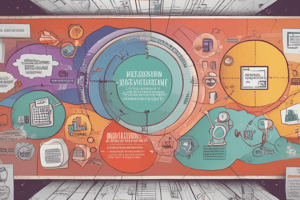Podcast
Questions and Answers
What characterizes a divisional structure in organizations?
What characterizes a divisional structure in organizations?
- Each division operates independently but reports to overall leadership. (correct)
- All divisions are managed by a central functional manager.
- Employees work in functional teams focused on specific tasks.
- There is a single hierarchical chain of command throughout the organization.
In which type of organizational structure are employees likely to have dual reporting relationships?
In which type of organizational structure are employees likely to have dual reporting relationships?
- Team-based structure
- Functional structure
- MATRIX structure (correct)
- Flat structure
Which organizational structure is primarily utilized by start-up businesses?
Which organizational structure is primarily utilized by start-up businesses?
- Hierarchical structure
- Flat structure (correct)
- Matrix structure
- Divisional structure
What is a major feature of a team-based structure?
What is a major feature of a team-based structure?
What distinguishes a network structure in an organization?
What distinguishes a network structure in an organization?
Which of the following is not considered an input for running a coffee shop?
Which of the following is not considered an input for running a coffee shop?
What internal activity is directly involved in transforming inputs into finished products in a coffee shop?
What internal activity is directly involved in transforming inputs into finished products in a coffee shop?
What is a significant benefit of feedback for a coffee shop?
What is a significant benefit of feedback for a coffee shop?
In the context of Humanistic Theory, which management style emphasizes individual fulfillment?
In the context of Humanistic Theory, which management style emphasizes individual fulfillment?
In what way does Theory X management perceive employee productivity?
In what way does Theory X management perceive employee productivity?
Which of the following represents an external motivating factor under a Humanistic Theory framework?
Which of the following represents an external motivating factor under a Humanistic Theory framework?
What is an example of output for a coffee shop?
What is an example of output for a coffee shop?
How does Theory Y management style approach remote work during inclement weather?
How does Theory Y management style approach remote work during inclement weather?
What characteristic is emphasized by the neo-classical theory in regard to organizations?
What characteristic is emphasized by the neo-classical theory in regard to organizations?
What primary challenge did Nokia face that led to its decline in the mobile phone market?
What primary challenge did Nokia face that led to its decline in the mobile phone market?
How does contingency theory define the effectiveness of organizational strategies?
How does contingency theory define the effectiveness of organizational strategies?
Which factor is NOT considered in the analysis required by the contingency theory?
Which factor is NOT considered in the analysis required by the contingency theory?
What is the main premise of open system theory regarding organizations?
What is the main premise of open system theory regarding organizations?
What significant strategy did Apple implement to remain successful in the smartphone industry?
What significant strategy did Apple implement to remain successful in the smartphone industry?
Which statement best describes the approach of modern organization theory?
Which statement best describes the approach of modern organization theory?
What is a key takeaway from the analysis of Nokia's failure?
What is a key takeaway from the analysis of Nokia's failure?
What is the primary focus of classical organization theory?
What is the primary focus of classical organization theory?
Which approach describes bureaucracy as the most efficient form of organization?
Which approach describes bureaucracy as the most efficient form of organization?
What did Frederick Taylor contribute to the field of organizational theory?
What did Frederick Taylor contribute to the field of organizational theory?
What outcome did the Hawthorne Studies reveal about worker productivity?
What outcome did the Hawthorne Studies reveal about worker productivity?
Which aspect does not align with neo-classical organizational theory?
Which aspect does not align with neo-classical organizational theory?
What is a key characteristic of decentralization in organizations?
What is a key characteristic of decentralization in organizations?
What does the human relations approach emphasize in an organizational context?
What does the human relations approach emphasize in an organizational context?
How do informal organizations impact productivity according to neo-classical theory?
How do informal organizations impact productivity according to neo-classical theory?
Flashcards are hidden until you start studying
Study Notes
Organization
- Comprises parts that must collaborate to achieve common goals effectively.
- Functions as a mechanism for people to coordinate actions towards valued objectives.
Organizational Theory
- Analyzes and predicts group and individual behavior in various organizational settings.
Classical Organization
- Prioritizes maximum efficiency and productivity with a rigid hierarchy.
- Employees have distinct roles and report to higher authorities.
- Jobs are simplified into repetitive tasks to enhance efficiency.
Major Approaches in Classical Theory
- Bureaucracy (Max Weber): Defines bureaucracy as an efficient organization with formal rules and a clear labor division.
- Scientific Management (Frederick Taylor): Introduced time-and-motion studies to optimize task performance.
Neo-Classical Organization
- Adopts a human-centered perspective, focusing on individuals and social factors in the workplace.
Focus of Neo-Classical Theory
- Human Relations Approach: Centers on the social and psychological requirements of workers, emphasizing employee relationships.
- Hawthorne Studies (Elton Mayo): Demonstrated that productivity increases when workers feel acknowledged, even without changes in physical conditions.
- Decentralization: Distributes decision-making powers, promoting autonomy and flexibility across various organizational levels.
- Informal Organizations: Informal groups significantly influence employee behavior and productivity, providing social support.
- Individual and Group Behavior: Recognizes that organizations consist of unique individuals with diverse motivations and personalities.
Modern Organization Theory
- Views organizations as adaptive systems that must respond to environmental changes for survival.
Case Studies
- Nokia’s Bankruptcy: Once a leader in mobile phones, Nokia failed to adapt to smartphone technology, losing market dominance.
- Apple iPhone: Maintained market leadership through continuous innovation, product expansion, and responsiveness to consumer needs.
Contingency Theory
- Effectiveness of strategies depends on specific organizational contexts.
- Requires managers to evaluate unique internal and external factors affecting their environments.
Open System Theory
- Organizations interact with their external environments, exchanging resources and information.
- Feedback from external sources is critical for assessing performance and making improvements.
Example: Coffee Shop Operations
- Input: Resources such as raw materials and human resources needed for operations.
- Processes: Internal activities for transforming inputs into services, including coffee brewing and inventory management.
- Output: Final products like beverages and customer experiences that contribute to sales revenue.
Humanistic Theory
- Explores motivation through external (punishments, rewards) and internal (job satisfaction, personal growth) factors.
- Management Style: Contrasts authoritarian (Theory X) and democratic/participative (Theory Y) approaches based on employee autonomy and trust.
Organizational Structure
- Functional Structure: Organizes by employee skills and expertise within the same company.
- Divisional Structure: Used by large companies with diverse products; each division operates independently.
- Team-Based Structure: Formed to solve specific issues or develop new products, integrating various roles.
- Flat Structure: Common in startups, minimizes hierarchy for direct communication.
- Matrix Structure: Employees report to multiple managers and divide their responsibilities.
- Hierarchical Structure: Structured authority with multiple layers of management.
- Network Structure: Involves partnerships and collaborations among different organizations.
Studying That Suits You
Use AI to generate personalized quizzes and flashcards to suit your learning preferences.




